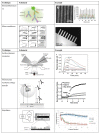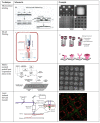Recent advances in bioprinting and applications for biosensing
- PMID: 25587413
- PMCID: PMC4264374
- DOI: 10.3390/bios4020111
Recent advances in bioprinting and applications for biosensing
Abstract
Future biosensing applications will require high performance, including real-time monitoring of physiological events, incorporation of biosensors into feedback-based devices, detection of toxins, and advanced diagnostics. Such functionality will necessitate biosensors with increased sensitivity, specificity, and throughput, as well as the ability to simultaneously detect multiple analytes. While these demands have yet to be fully realized, recent advances in biofabrication may allow sensors to achieve the high spatial sensitivity required, and bring us closer to achieving devices with these capabilities. To this end, we review recent advances in biofabrication techniques that may enable cutting-edge biosensors. In particular, we focus on bioprinting techniques (e.g., microcontact printing, inkjet printing, and laser direct-write) that may prove pivotal to biosensor fabrication and scaling. Recent biosensors have employed these fabrication techniques with success, and further development may enable higher performance, including multiplexing multiple analytes or cell types within a single biosensor. We also review recent advances in 3D bioprinting, and explore their potential to create biosensors with live cells encapsulated in 3D microenvironments. Such advances in biofabrication will expand biosensor utility and availability, with impact realized in many interdisciplinary fields, as well as in the clinic.
Keywords: biofabrication; bioprinting; immobilization; patterning; throughput.
Figures



References
-
- Tothill I.E. Biosensors for cancer markers diagnosis. Semin. Cell Dev. Biol. 2009;20:55–62. - PubMed
Publication types
Grants and funding
LinkOut - more resources
Full Text Sources
Other Literature Sources

